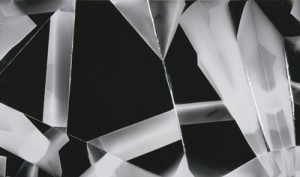« News, News US
Directions: Walead Beshty

Walead Beshty. Fold (60°/120°/180°/240°/300°/360° directional light sources), June 30th, 2008, Annandale-On-Hudson, Foma Multigrade Fiber, 2008. Courtesy of the artist and Wallspace, New York.
Hirshhorn Museum and Sculpture Garden (Washington D.C.)
April 30 - September 13, 2009
The Hirshhorn Museum and Sculpture Garden, the Smithsonian’s museum of international modern and contemporary art is exhibiting “Directions,” a solo show by Walead Beshty. This project features 11 new oversized photograms and a group of glass sculptures–both bodies of work make the artist’s process visible to viewers. The photograms update the cameraless photographic method pioneered by early 20th-century artists László Moholy-Nagy and Man Ray. These modern artists produced unique, black-and-white prints by placing objects on photosensitive paper and then exposing them to light. Working in both color and black-and-white, Beshty revises this historical technique by enlarging the scale of his photograms and making use of more contemporary technologies, such as color processors. In addition, rather than placing objects on photographic paper, Beshty folds or curls the paper before exposing it repeatedly to light, creating interlocking facets of prismatic color. The resulting works present themselves as seductive, elusive abstractions, yet they are actually material representations of the very process of their creation.
The titles of the works reassert this fact by detailing each object’s production, including the date and site of the darkroom facilities, as these variables influence the final work. The titles also note the type of photographic paper employed, because the paper’s physical characteristics, in part, influence both the feasible techniques and resulting forms, an inference to the fact that conventional discussions of photographic images pay little heed to the material matters.
Beshty’s “Directions” project also features a group of shatterproof glass sculptures fabricated to fit in standard-sized FedEx boxes. The pieces are then shipped via FedEx, rather than professional art shippers, between the artist’s studio and each exhibition venue. Evocative of both Marcel Duchamp’s “The Large Glass” and later Minimalist sculptures, Beshty’s glass boxes acquire additional cracks each time they are exhibited, thereby providing a visual trace of their physical movements and, more broadly, of the trafficking of contemporary art objects. The title of each glass sculpture denotes the various venues to which it was shipped, including the tracking number and transit time. Beshty’s titling method emphasizes the equal weight that chance and predetermined rules play in the creation of both his photograms and his sculpture: The artist is unable to predict the visual form that his works will take, nor can he reproduce a specific composition, even if he follows the same proscribed process.
The exhibition will be on view through September 13, 2009
Filed Under: News, News US


































